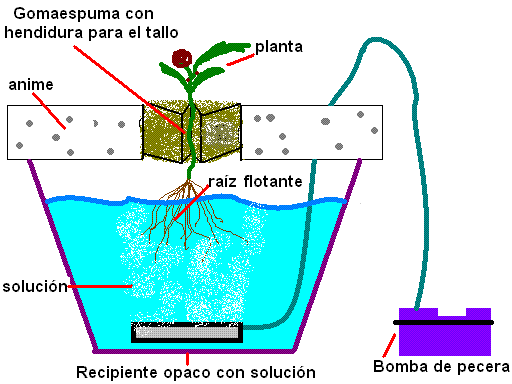Guide to making the simplest hydroponic growing system

The content of this article 'Guide to making the simplest hydroponic growing system' was prepared by www.hidroponicacasera.net and has been revised and republished by FreshFruitPortal.com.
There are many systems to grow using hydroponics, each one with its advantages and disadvantages, depending on what you want to plant and other conditions you have it is preferable to use one or the other.
But in any case, you must start with something.
I’ll share the simplest hydroponic growing system. Although it is probably not the best, the best way to learn is to do it, and this can be a good first step.
Requirements of any hydroponic system
- A plant support.
- A properly oxygenated nutrient solution in contact with the roots.
- To be able to change the solution as the water or nutrients are depleted.
- Solution should not be exposed to light.
You can complicate it all you want, but basically it is this. You can add water and air pumps, tubes to move everything, sensors, and a thousand other things, but if you have the above requirements, it works.
The simplest hydroponic growing system
The most basic system uses the bare minimum. Let's see the example for one plant.

This system needs:
- A container in which we have the nutrient solution.
- An aerator connected to a small air pump.
- A support for the plant.
We can develop this hydroponic growing system reusing materials we have at home, remember the liquid should not receive light, otherwise algae would grow.
As a container we could use any empty food can (such as a large can), conventional pots, opaque or painted plastic bottles cut in half.
To hold the plant, it is worth polystyrene or expanded polystyrene, a white cork of food trays or the bottle cap, among others.
For example, I plan to make one with a nesquik can, using the plastic cap as a support. It may be too small, but the best way to check it is to experiment.

The air pump logically has no homemade substitute, but it is cheap (it cost me 8,95€ in a pet store).
You could add a filter so that the water does not siphon and return through the tube to the pump, damaging it. Nutrients should also be purchased.
Nutrient solution in the hydroponic growing system
In this case we’ll talk about the nutrients that the plants need, which are dissolved in the water with which they are in contact.

Basic guide of nutrients for a hydroponic growing system:
Plants, like us, need nourishment. But unlike us, they make their own food, they are autotrophic. Like any factory, they need raw materials and energy.
It is well known that they get their energy from sunlight. Raw materials (i.e., elements) are from different sources:
From the air:
- Carbon: It is the skeleton of most molecules in plants and living things. Plants obtain it from CO2
- Oxygen
From water:
- Hydrogen
From salts through the roots:
- Nitrogen (N): It is part of many molecules needed by plants, especially proteins
- Phosphorus (P)
- Potassium (K)
- Micronutrients: Calcium, sulfur, iron, magnesium, boron, manganese, zinc, molybdenum, copper, cobalt, chlorine
In a hydroponic growing system, we must pay attention to the last group: the salts in our hydroponic liquid (or hydroponic solution).
The first three are demanded in very large quantities by the plants, they are part of the macronutrients.
The micronutrients, on the other hand, are needed in very small quantities, but are still just as necessary.
As you may have noticed, there are literally hundreds of different nutrient bottles, in a thousand shapes and colors, although all of them must contain these nutrients and inform in what quantity.
Usually, we refer to the first three with the acronym NPK, of its elements.
On the nutrient labels it says how much of each one there is, in the form of 3 numbers in a row, which indicate what percentage of each nutrient it has.
For example, a 5-5-5 solution has 5% nitrogen, 5% phosphorus and 5% potassium, for a total of 15%. The rest is water, micronutrients or other interesting or filler molecules.
Labels in hydroponics
We must pay attention looking at the labels, so our plants have everything in the quantity they need. Needs vary by species, growth stage and even seasons.
Take another look at the FloraMato label above, see the numbers?
1-2-5. Which means I was depriving my tomatoes of their nitrogen, an element they devour to grow.
And not only that. Because, among other things, the needs of plants change, nutrients are sold separately in different pots so that you can combine them according to your plants' needs.
In FloraMato there are no micronutrients, so the fact that they survived a month has merit.
I use FloraMato as an example because it is a mistake I made and I hope you learn from it what I learned, but without spending money.
I cannot say if the product is good or not since I haven’t used it in the conditions in which it should be used.
Summarizing hydroponic growing
When we look for nutrients for hydroponics, we must take care that they contain everything our plants need, usually distributed in different bottles.
The nutrients are nitrogen, phosphorus and potassium (NPK) and micronutrients.
It is best to check with the seller or on the manufacturer's website to find out which bottles are needed and how much of each one for each specific situation, as each manufacturer has different NPK and nutrient values.
Source: www.hidroponiacasera.net








































